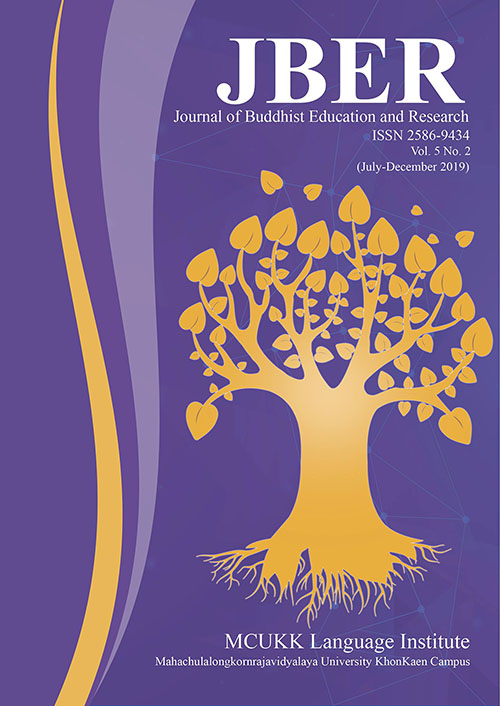การบริหารจัดการท่องเที่ยวทางพระพุทธศาสนาและวัฒนธรรม จังหวัดมหาสารคาม
คำสำคัญ:
การบริหารจัดการ, การท่องเที่ยว, พระพุทธศาสนา, วัฒนธรรมบทคัดย่อ
การศึกษาวิจัยนี้ มีวัตถุประสงค์ คือ เพื่อศึกษาสภาพการบริหารจัดการการท่องเที่ยวทางพระพุทธศาสนาและวัฒนธรรม จังหวัดมหาสารคาม เพื่อศึกษาปัจจัยที่มีอิทธิพลต่อการบริหารจัดการการท่องเที่ยวทางพระพุทธศาสนาและวัฒนธรรม จังหวัดมหาสารคาม และเพื่อวิเคราะห์ยุทธศาสตร์และกลยุทธ์การบริหารจัดการท่องเที่ยวทางพระพุทธศาสนาและวัฒนธรรม จังหวัดมหาสารคาม เป็นการวิจัยเชิงคุณภาพ (Qualitative Research) ผู้วิจัยได้ทำการรวบรวมข้อมูลจากเอกสารงานวิจัยที่เกี่ยวข้องและทำการเก็บรวบรวมข้อมูลภาคสนาม โดยการสำรวจข้อมูล (Survey) การสัมภาษณ์ (Interview) จากนั้นทำการสรุปวิเคราะห์ และสังเคราะห์ แล้วนำเสนอข้อมูลโดยรูปแบบการพรรณนาวิเคราะห์ตามหลักอุปนัย
ผลการวิจัยพบว่า
1.สภาพการบริหารจัดการท่องเที่ยวทางพระพุทธศาสนาและวัฒนธรรม จังหวัดมหาสารคาม พบว่า สภาพการบริหารจัดการท่องเที่ยวแบ่งเป็น 3 ประเภท คือ 1.การบริหารจัดการที่เป็นรูปธรรมได้คุณภาพ คือ 1) พระธาตุนาดูน 2. การบริหารจัดการที่เป็นรูปธรรมแต่ขาดการพัฒนา คือ 1) วัดพุทธมงคล 2) วัดพุทธประดิษฐ์ และ 3. การบริหารจัดการที่ขาดการส่งเสริม คือ 1) วัดชัยมงคล 2) วัดมหาชัย อย่างไรก็ตาม การบริหารจัดการท่องเที่ยวทางพระพุทธศาสนาและวัฒนธรรม จะใช้หลักการบริหาร คือ 1. การวางแผนประชุมปรึกษาหารือ 2. ขั้นดำเนินการ 3. ขั้นตรวจสอบ และ 4. ขั้นปรับปรุงแก้ไข หาแนวทางพัฒนาเป็นแหล่งท่องเที่ยวเชิงพุทธและวัฒนธรรมอย่างยั่งยืน
2.ปัจจัยที่มีอิทธิพลต่อการบริหารจัดการท่องเที่ยวทางพระพุทธศาสนาและวัฒนธรรม จังหวัดมหาสารคาม พบว่า ปัจจัยภายใน ได้แก่ 1. ด้านสิ่งดึงดูดใจ เป็นพุทธสถานศักดิ์สิทธิ์ที่ชาวพุทธได้ให้ความศรัทธาสักการบูชาอย่างสูง 2. ด้านสิ่งอำนวยความสะดวก เช่น มีห้องน้ำสำหรับคนพิการ ร้านอาหาร ศูนย์บริการข้อมูล ที่จอดรถ 3. ด้านการเข้าถึงแหล่งท่องเที่ยว มีถนนหนทางดี สะดวก และปลอดภัย 4. ด้านการรักษาความปลอดภัย มีการดุแลป้องกันทรัพย์สินของนักท่องเที่ยวเป็นอย่างดี และ 5. ด้านการบริหารจัดการการตลาด มีการจัดทำข้อมูลสารสนเทศต่างๆ ผ่านทางเว็บไซต์ เช่น Google และ Facebook และมีปัจจัยภายนอก ได้แก่ การท่องเที่ยวและวัฒนธรรมของจังหวัดมหาสารคาม องค์การบริหารส่วนส่วนท้องถิ่น โรงพยาบาลอำเภอ บริษัท ห้างร้าน พ่อค้า ประชาชน และผู้บริหารทางคณะสงฆ์ ต่างมือกันสนับสนุนสร้างเอกลักษณ์ให้กับแหล่งท่องเที่ยวประจำจังหวัดมหาสารคาม
3.ยุทธศาสตร์และกลยุทธ์การบริหารจัดการท่องเที่ยวทางพระพุทธศาสนาและวัฒนธรรม จังหวัดมหาสารคาม พบว่า ยุทธศาสตร์ 4 ด้าน ประกอบด้วยกลยุทธ์ 8 ด้าน ได้แก่ ยุทธศาสตร์ที่ 1. การบริการจัดการเชิงพื้นที่แหล่งทรัพยากร มีกลยุทธ์ คือ 1.1 ได้ก่อสร้างอาคารพิพิธภัณฑ์ เป็นแหล่งเรียนรู้เชิงประวัติศาสตร์ศาสนา สังคม และมรดกท้องถิ่น และ 1.2 ได้พัฒนาสิ่งแวดล้อมให้เป็นแหล่งท่องเที่ยวทางธรรมชาติ ยุทธศาสตร์ที่ 2. การส่งเสริมผลิตภัณฑ์สินค้าชุมชน มีกลยุทธ์ คือ 2.1 มีกิจกรรมร้านค้าจำหน่ายสินค้า OTOP ร่วมกัน โดยสร้างเอกลักษณ์ให้กับตัวสินค้าท้องถิ่น และ 2.2 มีการวางแผนด้านการตลาด พัฒนาสินค้าท้องถิ่น กล่องบรรจุภัณฑ์ทันสมัย สร้างเครือข่าย ยุทธศาสตร์ที่ 3. การบริหาเชิงบูรณาการ มีกลยุทธ์ คือ 3.1 ได้สร้างศูนย์ปฏิบัติธรรมประจำจังหวัด มีการอนุรักษ์วัฒนธรรม เช่น ฮีต 12 ครอง 14 และ 3.2 มีการพัฒนาบุคลากรเป็นเลิศด้านการบริการ พัฒนาการสื่อสารที่ดี และยุทธศาสตร์ที่ 4. การส่งเสริมแบบมีส่วนร่วม มีกลยุทธ์ คือ 4.1 มีการสร้างเครือข่ายแบบมีส่วนร่วม มีหน่วยงานทั้งภาครัฐและเอกชน และ 1.2 มีการบริหารด้วยหลักธรรมาภิบาล เช่น ด้านงบประมาณ บุคลากร เป็นต้น เพื่อพัฒนาการท่องเที่ยวอย่างยั่งยืนต่อไป
เอกสารอ้างอิง
กฤษฎา พิณศรี. (2550). การศึกษาศักยภาพแหล่งโบราณสถานวัฒนธรรม ล้านช้างในอีสานใต้เพื่อการท่องเที่ยวเชิงวัฒนธรรม. รายงานการวิจัย. มหาวิทยาลัยราชภัฏสุรินทร์.
จุฑาภรณ์ หินชุย และสถาพร มงคลศรีสวัสดิ์. (2557). แนวทางส่งเสริมการท่องเที่ยวเชิงพุทธกรณีศึกษาวัดประชาคมวนารามอำเภอศรีสมเด็จจังหวัดร้อยเอ็ด. วารสารวิชาการการท่องเที่ยวไทยนานาชาติ. 10(1).
นายพงษ์ภาณุ เศวตรุนทร์. (2561). ปี 2560 ประเทศไทยมีนักท่องเที่ยวต่างชาติ 35.38 ล้านคน อุตฯท่องเที่ยวสร้างรายได้รวม 2.75 ล้านล้านบาท. สืบค้นเมื่อ 24 มกราคม 2562 จาก http://www.362degree.com/ประเทศไทยมีนักท่องเที่ยว.
บุญชม ศรีสะอาด. (2535). การวิจัยเบื้องต้น. กรุงเทพฯ: สุวีริยาสาส์น.
ประยุทธ์ จันทร์โอชา. (2559). คำแถลงนโยบายของคณะรัฐมนตรีต่อสภานิติบัญญัติแห่งชาติ. สืบค้นเมื่อ 4 กันยายน 2559 จาก http://www.mots.go.th/ewt_dl_link.php?nid=6353.
พระมหาสุทิตย์ อาภากโร และ พระใบฎีกาสัญญา อภิวณฺโณ (สดประเสริฐ). (2559). ยุทธศาสตร์การท่องเที่ยวทางพระพุทธศาสนาและวัฒนธรรมของไทยและอาเซียน. วารสาร มจร พุทธปัญญาปริทรรศน์. 1(3).
สุรสวัสดิ์ สุขสวัสดิ์. (2539). ปัญหาการอนุรักษ์โบราณสถานและวัดในเชียงใหม่. รายงานการศึกษา. เชียงใหม่ : คณะวิจิตรศิลป์ มหาวิทยาลัยเชียงใหม่.





